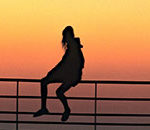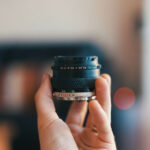Probably the most difficult and dangerous job in photography is that of a war photographer. Getty Photographer John Moore is no stranger to working in conflict zones having been on assignments in both Iraq and Afghanistan. In early 2011 he was assigned to Cairo to cover to growing uprising against President Mubarak. He arrived at the height of the violence, with loyalists attacking both protestors and journalists alike. Such was the danger the night he arrived, John was advised to go outside so he took to photographing the extra ordinary scenes unfolding from his hotel vantage point:
The following morning he attaches himself to the protesters, combining safety in numbers with some unique opportunities to create compelling images of the uprising, often showing the diversity of those protesting. John found himself inspired by the enthusiasm and hospitality of the protestors. He was in Tahir Square when Mubarak addressed the nation and captured the palatable sense of disappointment and anger of the protestors when the president refused to step down. By using a combination of wide shots showing all the protesters and closing in on individuals, John has created a powerful story to compliment the unfolding events.
Despite immense difficulties of photographic and exuberant and joyful crowd John also captured the moment Mubarak finally did resign, the joy in the faces of the Egyptian people has been beautifully recorded.
His work completed in Egypt, John flies out to Bahrain where a fledgling uprising has started. Although allowed into the country, his photographic equipment is confiscated by customs, perhaps fearing the potentially damaging images appearing in the worlds press. Undaunted he takes a taxi to the city center and buys a basic DSLR kit with lens and hits the streets to capture the ensuing violence. His shots are a prime example of how a good photographer can capture great images on any equipment, as well as a demonstration of his commitment to the job.

War and Documentary Photography by John Moore
Bahrain proved to be a more challenging and violent uprising than Egypt with the use of tear gas and live rounds featuring daily. From the film he appears to avoid showing the shock and horror images that we have become used to, and although he captures the violence, he also focuses on the human aspect of the unfolding story, the grief and despair or protestors and relatives.
His next assignment was in his own words one of the toughest he has ever encountered, the Libyan conflict. Joining other journalists in Benghazi John embeds himself with the rebels, journeying in convoy daily up to the front line. Being a much more arms based conflict with two heavily armed opponents, he has concentrated on capturing powerful images of a high intensity military conflict, combining the composition of a photographer’s eye with the intensity of war. As the rebel forces were pushed back they became worried that foreign journalists were giving away the rebels positions and became hostile towards them. John took this as a cue to leave, exiting from the eastern city of Benghazi. He took with him a compelling record of the three of the bloodiest uprisings in the Arab Spring, incredible images of a historic moment in the Middle East.
Like This Article?
Don't Miss The Next One!
Join over 100,000 photographers of all experience levels who receive our free photography tips and articles to stay current:






Leave a Reply